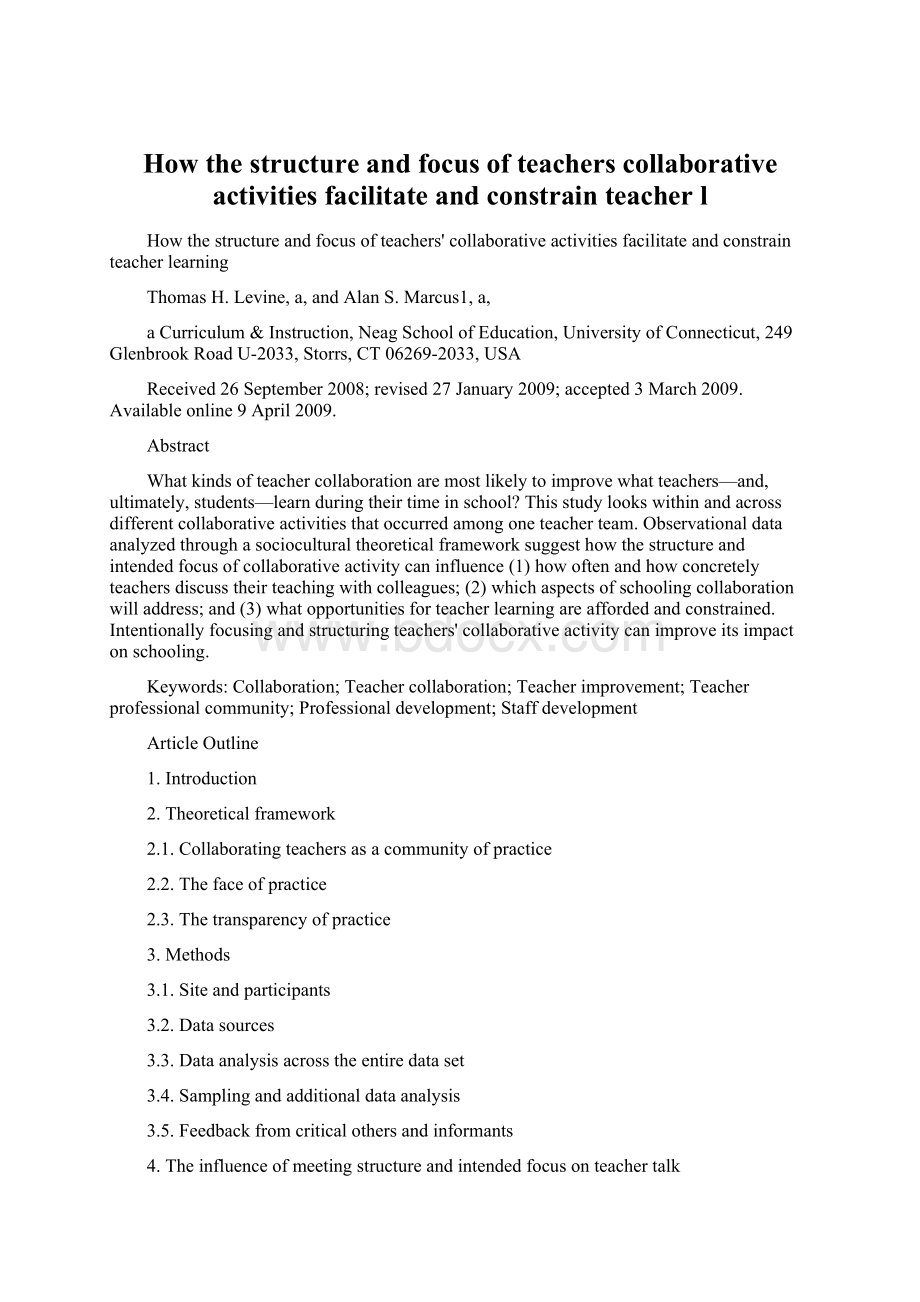How the structure and focus of teachers collaborative activities facilitate and constrain teacher l文档格式.docx
《How the structure and focus of teachers collaborative activities facilitate and constrain teacher l文档格式.docx》由会员分享,可在线阅读,更多相关《How the structure and focus of teachers collaborative activities facilitate and constrain teacher l文档格式.docx(21页珍藏版)》请在冰豆网上搜索。

Abstract
Whatkindsofteachercollaborationaremostlikelytoimprovewhatteachers—and,ultimately,students—learnduringtheirtimeinschool?
Thisstudylookswithinandacrossdifferentcollaborativeactivitiesthatoccurredamongoneteacherteam.Observationaldataanalyzedthroughasocioculturaltheoreticalframeworksuggesthowthestructureandintendedfocusofcollaborativeactivitycaninfluence
(1)howoftenandhowconcretelyteachersdiscusstheirteachingwithcolleagues;
(2)whichaspectsofschoolingcollaborationwilladdress;
and(3)whatopportunitiesforteacherlearningareaffordedandconstrained.Intentionallyfocusingandstructuringteachers'
collaborativeactivitycanimproveitsimpactonschooling.
Keywords:
Collaboration;
Teachercollaboration;
Teacherimprovement;
Teacherprofessionalcommunity;
Professionaldevelopment;
Staffdevelopment
ArticleOutline
1.Introduction
2.Theoreticalframework
2.1.Collaboratingteachersasacommunityofpractice
2.2.Thefaceofpractice
2.3.Thetransparencyofpractice
3.Methods
3.1.Siteandparticipants
3.2.Datasources
3.3.Dataanalysisacrosstheentiredataset
3.4.Samplingandadditionaldataanalysis
3.5.Feedbackfromcriticalothersandinformants
4.Theinfluenceofmeetingstructureandintendedfocusonteachertalk
4.1.Factorone:
thestructureofmeetings
4.1.1.Protocol-guided
4.1.2.Strongly-structuredandfacilitated
4.1.3.Looselystructured
4.2.Factortwo:
intendedfocusofmeetings
4.2.1.Instruction-focused
4.2.2.Student-focused
4.2.3.Schooloperations-focused
4.3.Frequencyofmeetingscategorizedbystructureandintendedfocus
4.4.Theinfluenceofstructureandintendedfocusonthefrequencyoftalkaboutinstruction
4.5.Theinfluenceofstructureandintendedfocusonthespecificitywithwhichpracticeisrevealed
5.Howdifferenttypesofactivitycreateddifferentopportunitiesforlearning
5.1.Instruction-focused,protocol-guidedmeetings
5.2.Instruction-focused,strongly-structuredmeetings
5.3.Student-focusedinformally-structuredcollaboration
5.4.Addressingorignoringaspectsofteacherswork
6.Whatkindsofcollaborationaremostlikelytoimproveschooling?
7.Professionalcommunity:
ifyoubuildit,willtheylearn?
Acknowledgements
AppendixA.Excerptofcodes
AppendixB.Acriticalfriendsprotocol
Criticalfriendsprotocol
Protocol
References
IntheU.S.,researchontheorganizationalnormsandconditionsofteachingpaintsaportraitofteachingasworkwhichiscarriedoutlargelyalone,withahighdegreeofautonomyandisolationfromcolleagues([Little,1990],[Lortie,1975]and[McLaughlinandTalbert,2001]).Whenteachersdointeract,theyusuallyvalueharmonyandcongenialityoveractivitiesthatriskconflictregardingthemeansandendsofschooling([Achinstein,2002]and[Little,1990]).Duringthepasttwodecades,animpressivearrayofscholarsandreformershavesoughttocounteractthetraditionalprivacyandisolationofU.S.teachers,callingforstrengtheningvariouskindsof“community”andpromotingteachercollaborationtoimproveteachingandlearninginschools(e.g.,[Cochran-SmithandLytle,1992],[DarlingHammond,1997],[DufourandEaker,1998],[FullanandHargreaves,1991],[LouisandMarks,1998],[McLaughlinandTalbert,2001]and[Meier,1995]).
Asmallbutgrowingbodyofresearchconfirmsthatparticipationinmorecollaborativeprofessionalcommunitiesimpactsteachingpracticesandimprovesstudentlearning(Vescio,Ross,&
Adams,2008).Forinstance,LouisandMarks(1998)studied24restructuringelementary,middle,andhighschools,showingthatthepresenceofmorecohesiveprofessionalcommunitycorrelateswithanobservableincreaseintheuseofsomedesirablekindsofpedagogy;
inaddition,85%ofthevarianceinstudentachievementwasaccountedforbythestrengthofaschool'
sprofessionalcommunity.Suchpositiveoutcomesmayoccurbecausemorecollaborativeworkingconditionscanleadwholedepartmentsorevenwholeschoolstodevelopsharednorms,values,practices,andorientationstowardscolleaguesandstudents([Achinstein,2002],[McLaughlin,1993],[McLaughlinandTalbert,2001]and[Westheimer,1998]).Teacherswhoindicatethattheyworkincohesiveandhighlycollegialprofessionalcommunitiesalsoreporthighlevelsofcommitmenttoteachingallstudents,highlevelsofenergyandenthusiasm,andhighlevelsofinnovation(McLaughlin,1993).Twothoroughreviewsofresearchonprofessionallearningcommunities([Bolametal.,2005]and[Vescioetal.,2008])concludethatteachercommunitiesaremosteffectivewhentheyfocusonstudentlearningorevidenceofsuchlearning.Onesystematicreviewof14studiesofcollaborativeprofessionaldevelopmentconcludedthatthepresenceofsuchongoingprofessionalcollaborationwas“linkedtomeasuredincreasesinstudentperformanceinallthestudies”(Cordingley,Bell,Rundell,&
Evans,2003,p.4);
tworeviewsofresearchonprofessionallearningcommunitiessupportthisclaim([Bolametal.,2005]and[Vescioetal.,2008]).
Althoughtwodecadesofresearchsuggestthatteachercollaborationandcommunitymatterforteachers'
workandstudentachievement,relativelylittleresearchhassoughttolookcarefullywithincasesofteachercommunitytounderstandwhether—andhow—differenttypesofteachercollaborationafforddifferenttypesofteacherlearning.Teachersmightdomanydifferentthingstogether.Whatkindsofteachercollaborationaremostlikelytoimprovewhatteachers—and,ultimately,students—canlearnduringtheirtimeinschool?
Howdodifferentkindsofactivitiesfacilitateandconstrainwhatteacherscanlearnfromtheirjointwork?
Withoutcleareranswerstothesequestions,itwillbehardertodesigneffectiveteachercollaboration,tosupportit,andtoknowwheretolooktoassesstheresults.Thisarticleaddressesthesequestionswhilereportingonacasestudyofintensive,ongoingcollaborationatoneschool.
Toexploreteachers'
opportunitiesforlearningfromcollaboration,weconceptualizeteachers'
ongoingworkwithcolleaguesasacommunityofpractice.WorksbyJeanLaveandEtienneWengerhavedevelopedtheconceptofcommunitiesofpracticetodescribesiteswherepeoplejointlyconstruct,transform,conserve,and/ornegotiatethemeaningsofpractices([LaveandWenger,1991]and[Wenger,1998]).Suchcommunitiesformwhenpeopleengageinasharedenterpriseovertime.Incommunitiesofpractice,thekeymechanismforindividualandgrouplearningcomprisesaccesstoobservingandthenparticipatinginthepracticesatthecoreofthecommunity.Thus,novicePh.D.researchersmightjoinaresearchgrouptogainaccesstopracticesassociatedwithresearch.Theyfirstwatchfacultyorexperiencedstudentswriteaninterviewprotocolanddoaninterview;
theylatermayco-interviewwithanexperiencedpeer,andgetfeedbackontheirfledglingefforts.Inacommunityofpractice,novices—andexperiencedpractitioners—canlearnfromobserving,askingquestions,andactuallyparticipatingalongsideotherswithmoreordifferentexperience.Learningisfacilitatedwhennovicesandexperiencedpractitionersorganizetheirworkinwaysthatallowallparticipantstheopportunitytosee,discuss,andengageinsharedpractices.Participantsinsuchcommunitieslearn—orjointlyconstruct—practices,whichcanbeunderstoodaswaysofachievingdesiredendsintheworldsuchasfacilitatingstudents'
learningofhistory.Practicescanbeunderstoodbothasteleologicalentities—ascontainingwiththemspecificpurposesorends—andassocioculturaltraditions,i.e.,socially-constructedwaysofbeingandactingintheworld.
Doctoralstudentscaneasilyengageinsharedpracticesineachother'
spresence;
collaboratingteachers,however,usuallymeetinatimeandplaceapartfromtheiractualengagementinteachingpractices(Little,2002).Withtheexceptionofteacherswhosecollaborationinvolvespeerobservationorjointteaching,mostcollaboratingteachersmustrepresenttheirworkverballyorthroughartifactsofpractice,suchasstudentworksamplesorlessonplans.Little(2002)hasstudiedteachers'
everydayconversationduringongoingcollaboration,andhastheorizedonseveralfactorslikelytoinfluencethelearningthatcanoccurinsuchsettings.Littleobservedthatmicropoliticalprocessesamongteacherscanleadgroupstoopenuporclosedowndiscussionofcertainaspectsoftheirwork;
thus,the“face”ofpracticewhichteachersmakepublicfortheirownreflectionandothers'
learningorcritiquecomprisesonekeyfactoraffectingwhatteachersmightlearnfromtheircollaborativework(p.934).
Inordertothinkaboutwhataspectsofteachers'
workarepartofthepubliclyavailablefaceofpractice,weidentifiedsixdistinctaspectsofsecondaryteachers'
workbasedonothers'
conceptualizations(Grossman&
Richert,1988)andourowndata.Thus,weareinterestedinwhetherthejointworkaddressesthefollowingaspectsofteacherswork:
contentandpedagogicalcontentknowledgespecifictotheirdiscipline;
classroommanagement;
pedagogy;
methodsofasses